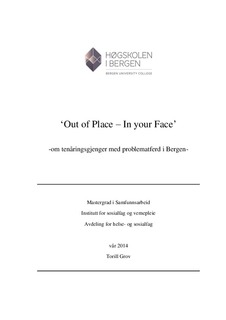| dc.contributor.author | Grov, Torill | |
| dc.date.accessioned | 2018-02-01T15:09:23Z | |
| dc.date.available | 2018-02-01T15:09:23Z | |
| dc.date.issued | 2014-06-25 | |
| dc.identifier.uri | http://hdl.handle.net/11250/2481876 | |
| dc.description | Masteroppgave i Samfunsarbeid | en_US |
| dc.description.abstract | Det finnes lite systematisert kunnskap om tenåringsgjenger med problematferd i Bergen og hensikten med prosjektet er å få økt kunnskap og forståelse innenfor temaet. Målsettingen har vært å se nærmere på noen forhold som kan føre til at ungdom oppsøker denne typen gjenger og hva slags identiteter og fellesskap som skapes her. Problemstillingen er: ”Hva kan bidra til veier inn, til ulike former for deltakelse, samt til veier ut av tenåringsgjenger med problematferd i Bergen?” Studien er en kvalitativ samfunnsvitenskapelig studie basert på intervju av 5 ungdommer i alderen 18-22 år, som var mellom 13 og 18 år ved gjengdeltakelse. I tillegg har jeg hatt uformelle samtaler med offentlige aktører med kjennskap til temaet. Datamaterialet er imidlertid i all hovedsak basert på intervjuene, det vil si via ungdommenes egne stemmer om deres erfaring og opplevelse av gjengdeltakelse. Datagrunnlaget blir analysert innenfor en hermeneutisk fenomenologisk tilnærming der intervjuene blir sett i lys av et samfunnsarbeiderperspektiv, valgt teoretisk referanseramme og empiri som kan bidra til å belyse temaet. Hovedfunn fra studien sammenfaller i stor grad med tidligere forskning. Jeg har valgt å fremheve noen funn. Det første er ungdommenes opplevelse av manglende anerkjennelse i møte med de voksne rundt. Det neste er at de unge først og fremst søker seg til et sosialt fellesskap med anerkjennelse og tilhørighet der de positive aktivitetene overskygger de negative aktivitetene. Et tredje funn er at ungdommene kan opparbeide ressurser, styrke og anerkjennelse for deltakelse i gjengfellesskapet. Jeg argumenterer for at dette kan være en form for sosial kapital som kanskje kan være nyttig å se på som gjengkapital. Det siste jeg trekker frem er at blant de offentlige aktørene unngår en å bruke gjengbegrepet samt at det ikke føres statistikk over tenåringsgjengene. Dette kan hindre oss i å se gjenger i utvikling, dele kunnskap og erfaring, og ikke minst se hvilke steder og grupperinger som til en hver tid fremstår som sårbar eller under press bl.a. for gjengdeltakelse. | en_US |
| dc.description.abstract | There is little systematic knowledge about teenage gangs in Bergen. The purpose of this study is to increase the knowledge and understanding within this subject. The objective has been to look into conditions for youth’s participation in such gangs and what might contribute to this. The data are mainly based on interviews. The data bring forth the adolescents’ own voices and experiences. The research question is: “What might contribute to paths into, to various forms of participation in, and paths out of teenage gangs with problem behavior in Bergen?” This is a qualitative social science study based on interviews with 5 young people, now aged 18-22 years, who have participated or been connected to a gang while they were between 13-18. To get an overview of teenage gangs and the public knowledge of the issue, there have been informal discussions with some public agencies. The data is analyzed within a hermeneutic phenomenological approach and according to the selected theoretical framework and with a community work perspective. The main finding of the study coincides largely with previous research, but I have chosen to highlight some findings. The first is the young people's experience of a lack of recognition in their relations with the adults around. The next point is that these young people are primarily looking for social community, recognition and belonging, and where the positive activities outweigh the negative ones. Another finding is that they gain some forms of resources, strength and recognition from their participation in the group. I argue that it might be a form of social capital and that it might be useful to look at it as gang capital. The last point I want to highlight is the public agencies’ reluctance to use the gang concept and to gather statistics of teenage gangs or similar groups. This may prevent us from seeing gangs in development, to share knowledge and experience, and not least to see which local areas and groups that appear to be vulnerable and therefore in risk of leading into excessive forms of gang participation at any time. | en_US |
| dc.language.iso | nob | en_US |
| dc.publisher | Bergen University College | en_US |
| dc.subject.other | samfunnsarbeid | en_US |
| dc.subject.other | sosial deltakelse | en_US |
| dc.subject.other | gjenger | en_US |
| dc.subject.other | ungdom | en_US |
| dc.subject.other | anerkjennelse | en_US |
| dc.subject.other | sosial identitet | en_US |
| dc.subject.other | sosial kapital | en_US |
| dc.title | "Out of Place - In your Face": Om tenåringsgjenger med problematferd i Bergen. | en_US |
| dc.type | Master thesis | en_US |
